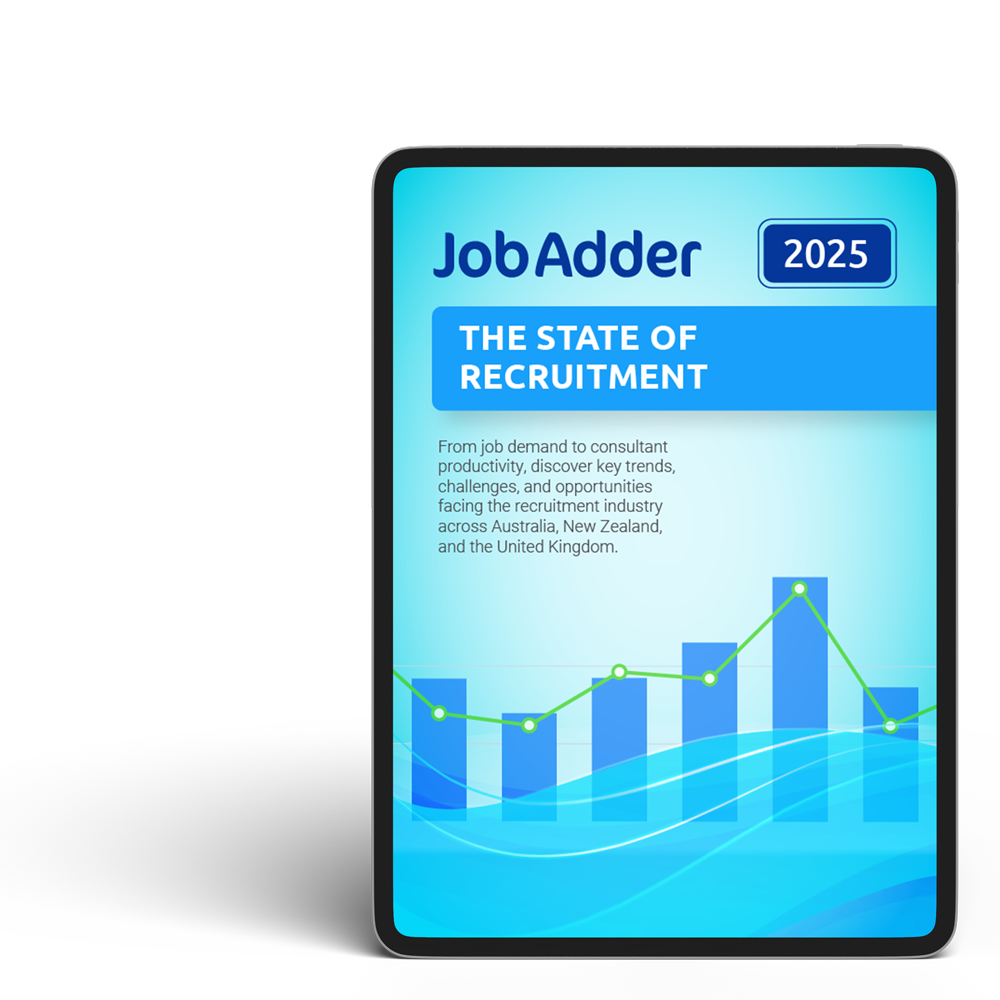Recruitment Blog
5 ways to boost recruitment efficiencies using AI

AI is fast becoming a mainstay in the way we work.
Savvy recruiters already understand this and are finding ways to tap into it: 69% of respondents to our 2025/25 Recruitment Benchmarking Report use AI and automation within their agencies, and a further 80% believe their use of AI will ramp up over the coming year.
With job applications at an unprecedented high – up 42% year-on-year according to our 2025 State of Recruitment Report – there’s a building pressure on recruiters to handle these high-volume applications without compromising quality of care. When used correctly, that’s where AI can be transformative.
AI: Where we are and where we’ve been
Joel Delmaire, JobAdder’s Chief Product Officer, says that although agencies have started tapping into AI, we’re still only scratching the surface.
“Seven years ago, traditional AI started dramatically improving part of the recruitment experience in fields like job search and job recommendations to job seekers. The next wave of GenerativeAI (GenAI) has the potential to be much more broadly applied, but we’re yet to see the breakthrough use cases that will transform the industry,” he says.
“Despite heavy investment, GenAI hasn’t yet had a significant impact on the recruitment industry. Rather than real transformations that will redefine workflows, we’re seeing smaller use cases such as improving speed. However, I anticipate the next couple of years will be pivotal for uncovering GenAI’s most effective applications in recruitment.”
Here’s how Joel suggests recruitment agencies can use AI to boost their efficiencies in 2025.
1. Automate administrative tasks
Recruitment is filled with time-consuming administrative tasks. By leveraging AI-powered tools, Joel says that recruiters can reduce the manual effort spent on routine tasks and dedicate more energy to what truly matters – connecting with top talent and building meaningful relationships.
“Many repetitive tasks for recruiters, such as candidate skills extraction and summaries, or comparing CVs to job descriptions, can be enhanced with AI,” he says. “For example, with applicant tracking systems, recruiters can automate application screening and run AI and skills-matching searches for applications they’ve received and on existing candidates in their database.”
While automation in recruitment has been around for years, Joel explains that the rise of GenAI will take efficiency to the next level.
“GenAI’s ability to make sense of unstructured, ambiguous data and seamlessly adapt to the context of each task has made it even more efficient,” he says.
2. Improve job advertisements
A well-crafted job advertisement is often the first touchpoint between a company and potential candidates. However, writing compelling and informative job descriptions can be time-consuming.
Joel says AI is now transforming this process, helping recruiters generate high-quality job postings that attract the right talent.
“AI can help recruiters write high-quality job advertisements, ensuring all the right information is available for a job seeker to understand the role and make an informed decision about applying,” he explains.
However, Joel cautions that the human touch is still critical, and AI can’t be relied on fully for crafting job descriptions.
“AI-generated job descriptions should be treated like a ‘first draft’. These first drafts can act as a strong foundation for the recruiter to refine and tailor the message, ultimately saving time,” he says. “At the end of the day, human judgement must always be applied though, to avoid unexpected biases or errors.
3. Use AI in your workflows, not as a separate tool
AI has the potential to revolutionise recruitment, yet its adoption has been slower than expected. Joel says there could be a few key reasons for this.
“There are challenges to fully integrating AI into existing workspaces,” he says. “Recruiters have to input a lot of information that already exists in their systems, stepping outside their platform to do a task.
It’s not that the capabilities of GenAI aren’t there, it’s just that they’re not integrated into the flow and aren’t convenient today, which creates a lot of friction in adoption.”
With that said, Joel believes this gap will likely be filled in the near future.
“I think this challenge will shift significantly over the next couple of years as software companies learn how to integrate it into the workflow. For now, recruiters can try to reduce this friction by having clear and detailed templated actions for repetitive tasks.
4. Upskill teams with AI training
AI is reshaping many industries at an incredible pace, and recruitment is no exception. However, as Joel explains, simply having access to AI tools isn’t enough.
Agencies need to ensure their teams are equipped with the skills to use them effectively. Without proper training, even the most advanced AI solutions can go underutilised, leaving businesses behind in an increasingly competitive market.
“Organisations that invest in training their teams on AI proficiency will gain a competitive edge,” Joel says. “There’s a strong correlation between companies that excel at using AI and those that provide formal training and implement systematic initiatives within their organisation.
At JobAdder, we provide significant training to our development team, and we’re looking at company-wide initiatives, like hackathons, to explore how to best use AI across the organisation.
Recruiters who upskill themselves in AI technologies now will be well-positioned to take advantage of future advancements.”
5. Focus on problems, not on technology
With the rapid rise of AI, it’s easy for agencies to get caught up in the excitement of new tools and features. However, successful adoption isn’t about using AI for the sake of it; it’s about solving real problems.
Joel advises recruiters to start their journey by identifying their biggest pain points and then exploring how AI can provide meaningful solutions.
“Understanding the unique challenges you face as a recruiter or agency first, then identifying where AI can assist will be key,” he says.
And if you’ve looked into all this before with less-than-ideal results, Joel says now might be the right time to relaunch your efforts.
“Some problems that couldn’t be solved with more traditional technology could possibly be solved by GenAI now. Recruiters should identify their biggest pain points and experiment with AI-driven solutions to determine where the technology can provide the most impact.”
Looking ahead to the future
While AI’s full potential in recruitment is still unfolding, recruiters who embrace its capabilities now will be better prepared for the changes ahead. If the past is any predictor, Joel believes that the technology is likely to take a few more years to start deeply transforming the industry.
“At JobAdder, we’re particularly focused on AI use cases where recruiters have to understand or generate large volumes of unstructured data, such as understanding a large number of resumes, summarising candidate profiles and writing job advertisements,” he says. “These are all areas where AI can make a tangible difference today.”
To learn more about JobAdder and how our products can help you boost your recruiting efficiencies, book a free demo with our team today.
Related blog posts

In today’s dynamic recruitment landscape, agencies face an ongoing challenge of balancing business development (BD) efforts with client retention strategies. …
Ready to get started?
Talk to one of our friendly team members


